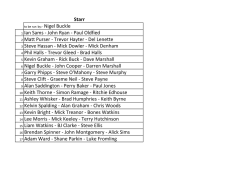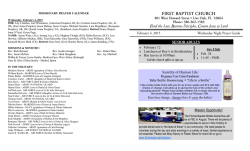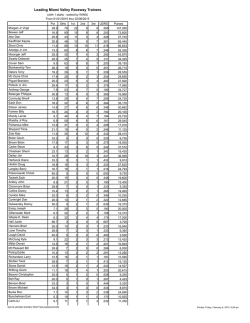
Obituary - Biochemist e
Obituary Stephen Allan Baldwin (1952–2014) Stephen Allan Baldwin, known to his many friends and colleagues as Steve, passed away on 13 November, 2014 aged 62. He grew up in Southport in Lancashire, one of three children. His father was an airline pilot and his mother, a potter. He developed interests in outdoor activities, natural history, and in chemistry, which he explored in their garden shed. In 1970 he won a Scholarship to Trinity College, Cambridge to study the Natural Sciences Tripos, specializing in Biochemistry in his final year. Here he met Jocelyn from Norwich and New Hall, also studying Part II Biochemistry, and they married in 1973 after graduation. They remained in Cambridge while Steve undertook research for a PhD degree supervised by Richard Perham in the Biochemistry Department. In 1978 their first papers on purification and characterization of Fructose 1,6 bisPhosphate Aldolases were published in the Biochemical Journal1, a journal where Steve continued to publish throughout his career2. Like many at that time, Steve and Jocelyn became part of the ‘brain-drain’ and set off for the USA to work with Gus Lienhard on the purification and characterization of the glucose transport protein from human red cells. Thus was born Steve’s long-term interest in biological membranes, and his many contributions to the understanding of glucose transport in mammalian cells, and its role in insulin reception and 42 February 2015 © Biochemical Society diabetes. In 1981 they returned to London where they met Jack Lucy, another scientist working with biological membranes. Steve raised antibodies to the glucose transport protein he and Jocelyn had purified, and this enabled the ground-breaking sequence and putative structure of the human glucose transporter published with American collaborators in Science in 19853. Their two sons, Chris and Alex were born in 1984 and 1986. Steve took up a Senior Lectureship at the Royal Free Hospital (London) in 1988 where he became a Reader in 1992. During this period a second focus of his lifelong research then evolved on the activities of nucleoside transport proteins, based on his early characterization of the process in mammalian erythrocytes. Again, he exploited antibodies to identify the protein involved; this generated sequence information from which the gene could be identified. While refereeing a grant proposal of Peter Henderson’s on bacterial sugar transporters Steve realized there was a profoundly important similarity between human and bacterial transport proteins, and so the first members of the Major Facilitator Superfamily were recognized. Peter and Steve published this together in Nature4 in 1987, and they collaborated on-and-off ever since – their most recent paper was in 20135. In 1992 Peter and his family moved to Leeds and Steve and Jocelyn and the boys came in 1993. Steve and Peter have occupied neighbouring laboratories ever since, first in the then Biochemistry Department, and subsequently in the Astbury building, as founding members of the subsequently very successful Astbury Centre for Structural Molecular Biology. The great majority of Steve’s science was done independently and with a much wider group of collaborators from all over the world – Canada, USA, Chile, India, Pakistan, Malaysia, Spain, many European countries and most recently, China. Not to mention many UK Universities – including Imperial College, Oxford, Cambridge, Bristol, Manchester, Glasgow, Edinburgh, Sheffield and York. With a group from Glasgow University Steve led the Membrane Protein Structure Initiative, out of which emerged important structures of proteins involved in peptide transport6. He was also a group leader in the European Drug Initiative for Channels and Transporters (EDICT), and was very successful in advancing studies on structures and activities of transporters of biomedical interest. Steve’s research had an impact on many areas of membrane biology, especially in the clinical domain. If we had to single out his major contributions they would be in the early development of understanding diabetes, and in understanding the role of nucleoside transporters in cancer chemotherapy. Steve loved his research: “Biochemistry is my hobby”, he would say. Over 100 students and postdoctoral researchers trained under Steve’s supervision, and he rejoiced in the high quality of their research and the publications (more than 200) they produced together. Through working with Steve, their horizons broadened and their ambitions grew. The theses they presented for their PhD degrees and their successes in science and many other walks of life constitute a major legacy of his. Obituary So why did everybody love working with Steve? Well first the mercenary reason – he was brilliant at writing grant applications! He grasped the essence of what was wanted by the sponsors, he thought deeply about the relevant issues, and he composed a series of carefully-conceived and meticulous arguments. Very many of us are literally in his debt for these contributions to our professional well-being. This meticulous and thoughtful approach extended to all Steve’s activities. He was the exemplar of the ‘good citizen’ of our Institution, supportive, inclusive, and collegiate. His enthusiasm and willingness to embrace and share new ideas and his breadth and depth of knowledge were exceptional. He had one infuriating fault! He turned self-deprecation and modesty into an art form. Before or after some brilliant contribution, insight, or assistance he would say — in all sincerity — what rubbish it was and likely to be. A favourite expression was “I am as useful as a chocolate teapot”. Nothing could be further from the truth. But the real reason Steve left an impression on so many people can be found in the numerous personal tributes we have received; a very small number of which are paraphrased here: “Steve was as lovely a guy as he was a talented scientist… a lovely man and fine scientist … an excellent scientist and a very pleasant colleague… a gentleman… a very fine man indeed and a wonderful scientist … a warm and friendly individual with boundless enthusiasm for his science … an inspirational example of academic honesty and kindness for all those working under his supervision … the truly model scientist I wish myself to follow.” These expressions of personal esteem came from all backgrounds, from secretary to Nobel Laureate, from student to professor, from Chile to Japan, from Bristol to Aberdeen Unfortunately Steve became ill only shortly after he took early ‘retirement’ although he continued to work just as hard as previously continuing to develop his innovative science. Despite the various setbacks and difficult treatments that he had to suffer Steve persisted in keeping busy and it was humbling to see him coping with his illness. Throughout Steve’s busy career Jocelyn was a partner in his research activities as well as providing the personal and family life he truly appreciated. To Jocelyn, Christopher, Alexander and all Steve’s family, we offer our heartfelt sympathy at the loss of a great friend and mentor. ■ Peter Henderson, Alison Baker and Vincent Postis (University of Leeds) References 1. Baldwin, S.A. and Perham, R.N. (1978) Biochem. J. 169, 643–652 2. Huysmans, G.H., Chan, N., Baldwin, J.M. et al. (2012) Biochem. J. 445, 157¬–166 3. Mueckler, M., Caruso, C., Baldwin, S.A. et al. (1985) Science 229, 941–945 4. Maiden, M.C.J., Davis, E.O., Baldwin, S.A., Moore, D.C.M. and Henderson, P.J.F. (1987) Nature 325, 641–643 5. Henderson, P.J.F. and Baldwin, S.A. (2013) Nature Struc. Mol. Biol. 20, 654-655 6. Newstead, S., Drew D., Cameron, A.D., Postis, V.L. et al. (2011) EMBO J. 30, 417–26 February 2015 © Biochemical Society 43
© Copyright 2025



